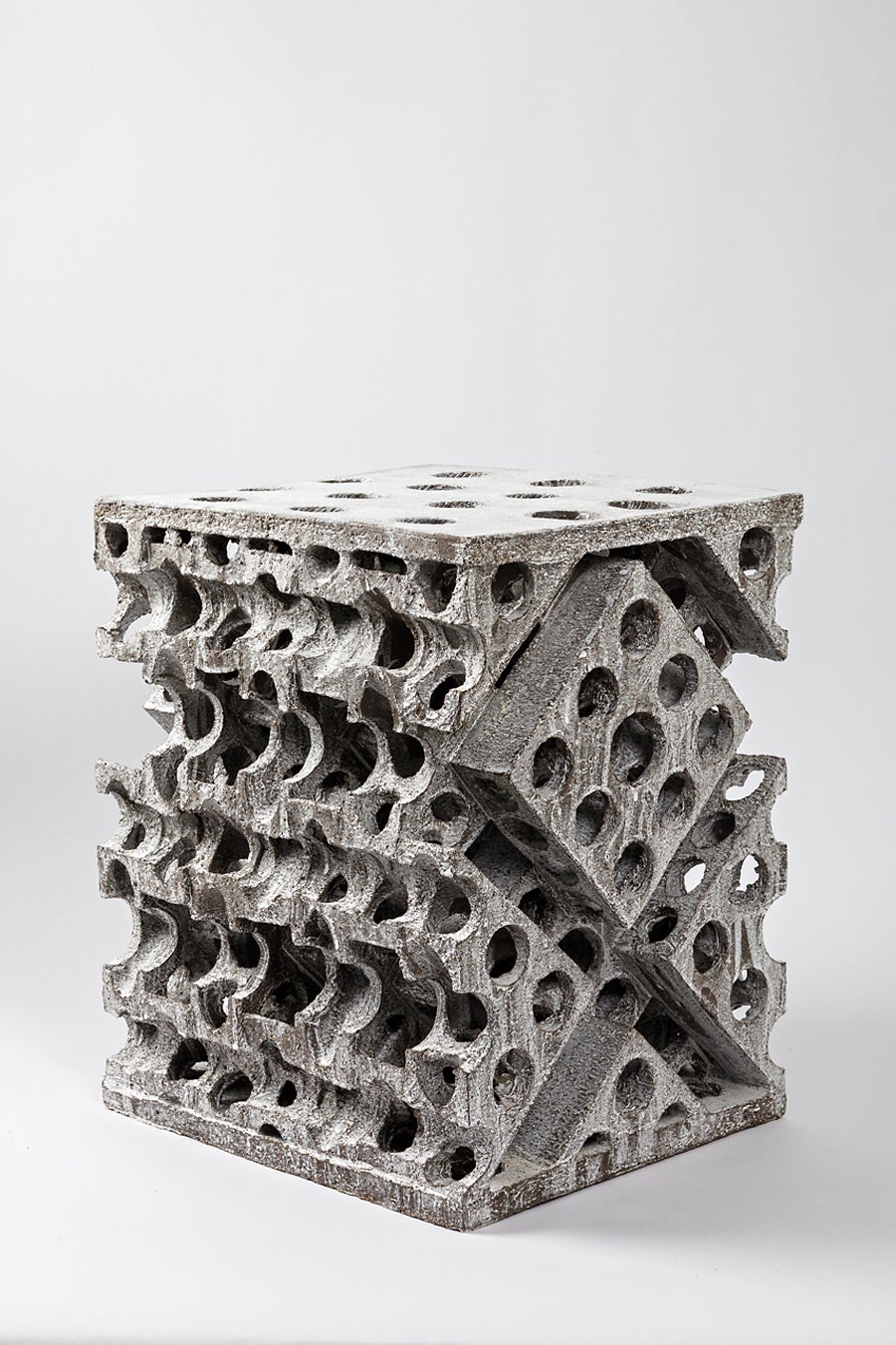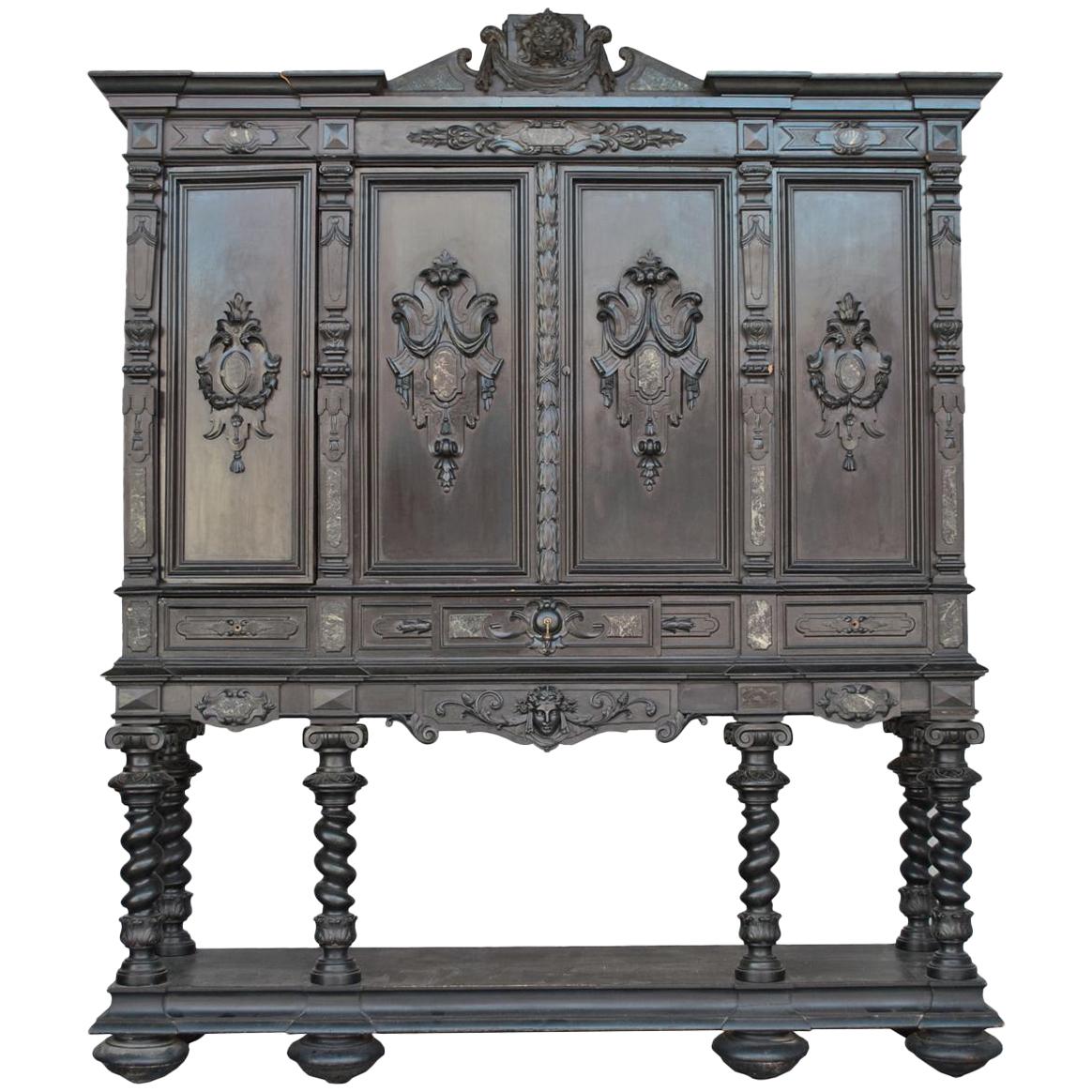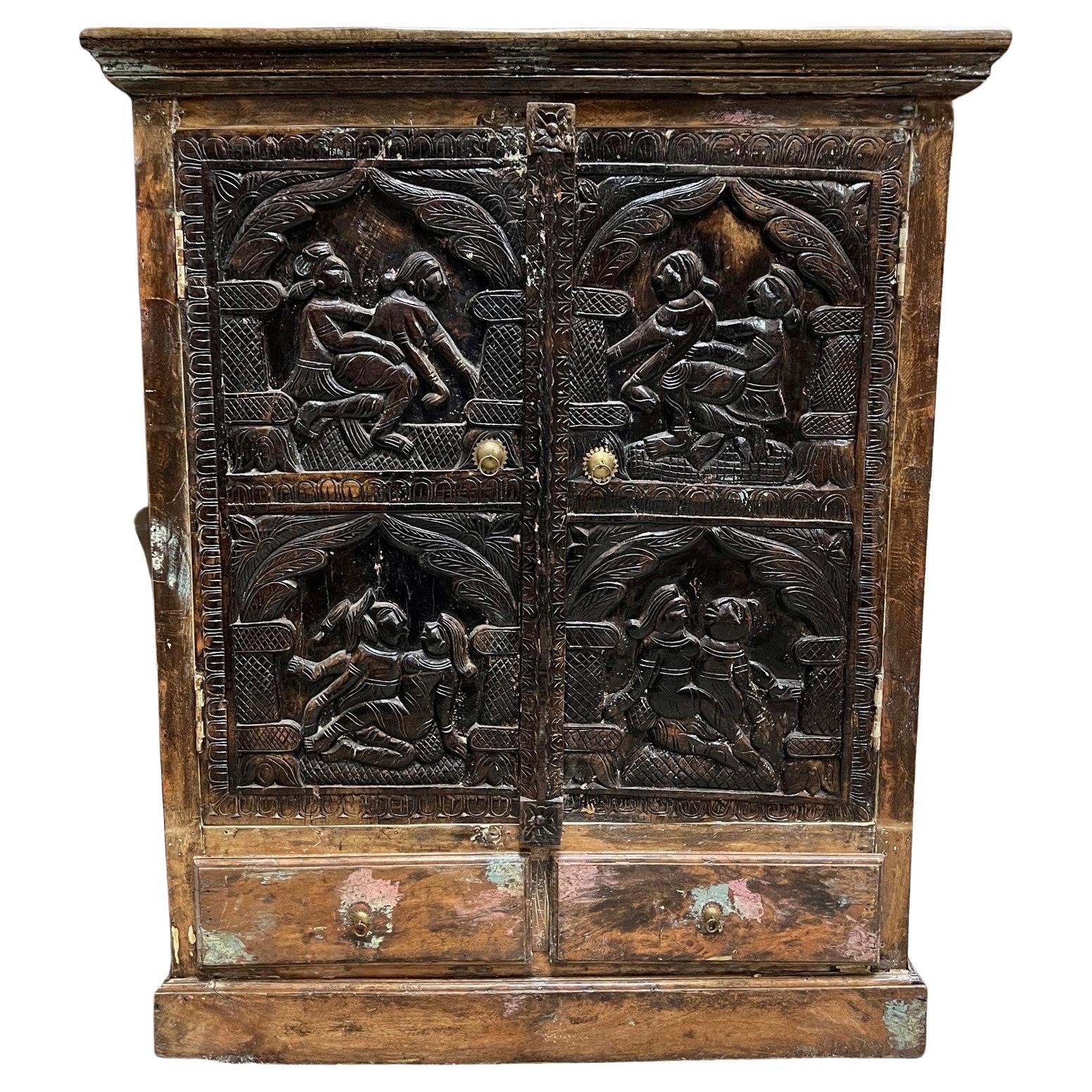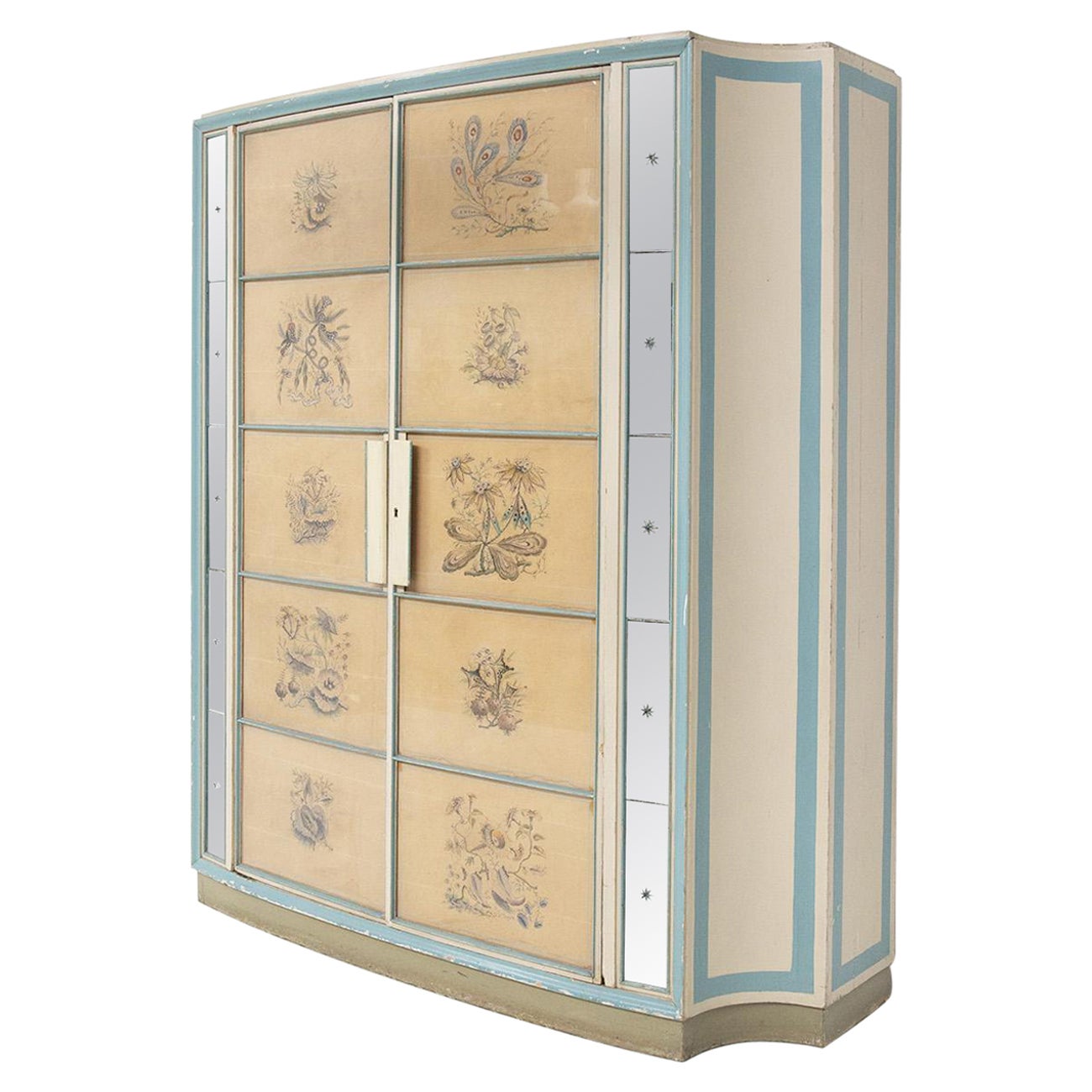Items Similar to Important Cabinet with Two Body in Blackened Wood Carved and Engraved
Want more images or videos?
Request additional images or videos from the seller
1 of 7
Important Cabinet with Two Body in Blackened Wood Carved and Engraved
About the Item
IMPORTANT CABINET WITH TWO BODY IN BLACKENED WOOD CARVED AND ENGRAVED
ORIGIN: FRANCE
PERIOD: 17TH CENTURY
Height: 188 cm
Width: 135 cm
Depth: 53.5 cm
Blackened wood and veneer: rosewood, ebony, pear, mahogany
Framed in oak wood
A real ceremonial piece of furniture, this two-part cabinet opens with two historiated panels and two drawers in the upper part and two leaves and two belt drawers in the lower part.
Richly worked, it offers both inside and outside a floral decoration, finely engraved which contrasts with the importance given to geometric lines. This duality, typical of this type of cabinet, confirms its dating and its origin.
In addition, the gilded metal locks and fittings enhance the sumptuous trait of this piece of furniture and also contribute to its ornamentation.
Furniture of predilection for “enclosing the most precious things” (Furetière, Dictionnaire, 1690) the appearance of cabinets in the 16th century accompanied the development of wunderkammern, these cabinets of curiosities enriched both by the vogue for the antique and by distant expeditions which bring back with them natural wonders and rare testimonies of distant civilisations. The curious, combining fortune and culture, brings together antique medals, rare plants, fossils, or oriental ornaments. This meeting of pieces which embodies much more than their material reality, a subjective evocation of all the riches of the earth and all the knowledge of men, acts in the eyes of its owner like a microcosm of which he is the master and which he enjoys according to his will.
This is how the first cabinets were designed to be transportable, often wooden structures calling for riches only those they housed for a collector who refused to part with them, even temporarily.
In the 17th century, the cabinet gained in technical complexity and luxurious materials until it could no longer be moved itself and became a prized and expensive collector’s item that was found to varying degrees in the homes of the as well as the prince.
Kept in the eponymous room of the apartment, intimate and reduced, the cabinet creates a mise en abyme among the rest of the collection which continues beyond the piece of furniture, lining the bedroom (Kammer). Indeed, in the 27 drawers of this cabinet was conserved a collection in the collection, perhaps archaeological fragments or shells from overseas, perhaps refined perfumes or precious jewels.
Cultivating the taste for merit and surprise specific to the curious, the manipulation of the cabinet obeyed three stages.
Closed, in the upper part, it offers two scenes in bas-relief carved in geometric medallions around which are inscribed geometric cartouches with a motif of finely engrave foliage scrolls.
On the lefts leaf is what could be a triumphal entry of a king into the city. A royal entrance is defined by the historian Pascal Lardellier as a major political rite consisting “for a city to officially welcome a sovereign or a high dignitary, in an architectural and theatrical setting prepared for the occasion”. We see a rider richly dressed in the Roman style carrying a sceptre, surrounded by two dancing musicians. In the background, we can see two men at a window watching the show.
The opposite medallion presents a scene that is more difficult to identify. We see a Roman soldier and two men talking. On the left, a boat taked shape which can make us say that the scene is held in a port. In the distance, the city emerges with its tower and its dome.
The character on the right, richly dressed, a sword at his waist, carries a sceptre in his left hand and points to the city with his right hand. The character on the left has in his right hand the same hat than the character described above. He seems to point to the ship. In the centre, the Roman soldier recognizable by his armor, his helmet and his spear listens to the first character. Maybe it is a commercial scene ?
Once the two leaves are open, 14 drawers are revealed framing two leaves engraved with a fruit basket from which a flower rises. The interior of the main leaves is also engraved and uses the same fruit and flower basket pattern with a few variations.
Finally, the last opening reveals a luminous space reproducing in wood marquetry, a theatre. This feigned structure, reminiscent in its polychromy of the churches of Tuscany, is framed by nine small drawers. In the upper part of the alcove, at the base of the opening as well as on the reverse of the two leaves, is a rose-des-vents in marquetry. To accentuate the effect of perspective, a checkerboard is created at the base of the alcove and leads the eye to a landscape painted on wood which is reflected in the two mirrors arranged on either side of the representation.
The cabinet surprises with its well-executed ornamentation which exploits historiated reliefs, plays of light and coloured marquetry, preserved in an exemplary manner.
- Dimensions:Height: 136 in (345.44 cm)Width: 135 in (342.9 cm)Depth: 53.5 in (135.89 cm)
- Materials and Techniques:
- Period:
- Date of Manufacture:17th Century
- Condition:Repaired. Wear consistent with age and use. Minor losses. Minor structural damages.
- Seller Location:Saint-Ouen, FR
- Reference Number:1stDibs: LU3115336035272

About the Seller
5.0
Vetted Seller
These experienced sellers undergo a comprehensive evaluation by our team of in-house experts.
Established in 2016
1stDibs seller since 2017
153 sales on 1stDibs
Typical response time: 7 hours
- ShippingRetrieving quote...Ships From: Paris, France
- Return PolicyThis item cannot be returned.
More From This SellerView All
- 16th Century Renaissance Two-Bodied CabinetLocated in Saint-Ouen, FRFormer collection Altounian At the beginning of the reign of Henri II (1547-1559) the furniture’s ornamentation evolves. The few medieval motifs that were still used are eventually relinquished. Furniture becomes more sober showcasing moulded panels and perfect architecture. Cabinet-makers use ornaments such as curved fluted or plain columns, feather quills, roses or winged putti heads. High-relief carving becomes more scarce and compositions lighter. To that end cabinet-makers draw inspiration from Fontainebleau motifs filtering them and adapting them to French taste. During this period cabinet-makers turn into a kind of architects. Indeed the architectural balance of furniture is the centre of their concerns. The study of Antic formulas is then a necessity. From this care given to proportions appear refined cabinets with pure lines. This style is characteristic of the reign of Henri II and disappears soon after under the regency of Catherine de Medici (1560-1574) when an abundance of high and low-relief ornaments comes back on furnitures. This two-bodies cabinet...Category
Antique 16th Century French Renaissance Cabinets
MaterialsWalnut
- 16th Century Two Bodied Genoan "Stipo" Cabinet with a Bambocci DecorLocated in Saint-Ouen, FRThis stipo, little Italian cabinet made of walnut and walnut burl, is a remarkable example of Mannerism applied to decorative arts during the late 16th century. While the Manneris...Category
Antique 16th Century Italian Renaissance Cabinets
MaterialsWalnut
- Small Two-Body Buffet Decorated with Bird QuillsLocated in Saint-Ouen, FRSmall two-body buffet decorated with bird feathers ORIGIN : FRANCE PERIOD : 16th CENTURY Measures: height: 170 cm length: 106 cm depth: 51 cm Walnut wood This cha...Category
Antique 16th Century Renaissance Cabinets
MaterialsWalnut
- Important Renaissance Cabinet from Lyon 'France' with a Decor of PerspectivesLocated in Saint-Ouen, FRAs soon as 1540 France's second Renaissance is in the making, intimately linked to the rediscovery of the Antique world. The development of the printing and engraving industry allows the spread of artworks and models in many cities and countries. The Italian influence can be perceived in every artistic field. While the French king entrust the most talented Italian artists with major projects such as Il Rosso or Primaticcio in Fontainebleau, French artists also travel to Italy to form themselves to this new style. In Italy they get acquainted with the work of Leo Battista Alberti the first to theorize perspective (De Pictura, 1435-36) and architecture (De re oedificatoria, 1541). Those two publications would have a revolutionary impact on arts. Furniture is marked by the work of the most famous Italian architects of the time as well as French architects. Indeed Philibert de l'Orme competes with Alberti and by the end of his life publishes several treaties including one devoted to a theory of architecture (1567). Unfortunately he would not live to complete the second volume. In this treaty he expresses his interest for mathematical norms applied to architecture, copied from the Antique. His journeys in Italy allowed him to accumulate the most sophisticated references. Jean Bullant, another architect of great talent also theorizes his practice. He establishes rules characterizing Greco-Roman art staying faithful to Vitruvius. Following this new inspiration the structure of furniture evolves. From then on appear columns, capitals, cornices, friezes and architraves. The ornamentation uses this inspiration as well with egg-and-dart, palm leaf and rose adorning the most beautiful pieces. In Lyon, crossroad where meet merchants from everywhere those new experiments are welcomed. Lyon florishing printing industry allows the spreading of models and treaties essential to the artist's work. Thus the first publication of Vitruvius' De Architectura in France would be printed in Lyon in 1532. Artists from Lyon rediscover and familiarize themselves with the Antique knowledge very early. They adopt those new ideas and use them in their own creations. Lyon cabinet-makers re interpret Antique architecture and Italian Renaissance palaces to give their pieces a pure and harmonious architectural structure. Grooved pilasters are particularly favored. They are topped by capitals of diverse orders always respecting the sequencing with simpler ones for the lower levels and the richest ones on the higher levels. As for the ornamentation, one of the great distinctiveness of Lyon workshops remains the architectural perspective illusions, drawing inspiration from Tuscany. True masterpiece of the Second French Renaissance this important cabinet illustrates Lyon workshops' taste for fine Italian architecture inspired by Antiquity. An architectural perspective of great quality is treated in symmetry on each panel. This two-bodied cabinet without recess stands on four rectangular feet. The base comprises a molding, a palm leaf frieze and is bordered by a braid. The lower body is divided by three grooved pilasters with Tuscan capitals framing two door-leaves. The two panels are encircled by a moudled frame with palm leaves. They are finely carved with a decor of fantasized architecture depicting an Italian Renaissance palace erected symmetrically on each side of a grooved pilaster. On the ground floor a door opens through a stilted arch while the stories are opened with mullioned windows, dormers and occuli. Two large pegged-boss cladded pillars support the entablature enriched by a palm leaf frieze upon which stands an arch whose coffered intrados is centred by a rose. Behind this arch a pyramid appears, standing in front of a second facade with a window topped by a broken curvilinear pediment under a cul-de-four with a shell. The checker flooring gives depth to the low-reliefs creating vanishing points structuring the panels and guiding the eye of the observer. A thin laurel braid highlights the belt of the cabinet where are located two drawers. Their facades are adorned by palm leaves in hoops. The upper body is encircled with palm leaves. The same ternary division as in the lower body appears. However, the pilasters are topped by Ionic capitals with volutes and egg-and-dart. The door-leaves are framed with flowers. On the panels the artist has designed another architectural decor. On the foreground open two arches on top of grooved pilasters with rectangular capitals adorned with palm leaves. The arches are enriched with braids and the coffered intrados bears a decor of roses. The spandrels also bear a flower decor. In the background another arcature hosts a fluted grooved column topped with double basket acanthus capital, characteristic of Corinthian order. The triangular pediment is interrupted by a choux bourguignon. A large cornice crowns the cabinet. It stands on pilasters and forms an entablature comprising a palm leaf frieze and an egg-and-dart, triglyph and palm leaf cornice. The cabinet's sides have also been carefully considered. The lower body's panels are enriched with an arch rising above a broken pediment portico hosting a twisted column. Flowers garnish the spandrels. An architectural facade completes the decor. The upper body's panels present two arches supported by a facade opened with dormers and mullioned windows as well as cartouches (one bears the inscription 1580 dating the cabinet) suggesting the interior of an Italian Renaissance palace, confirmed by the chandeliers. The flooring leads our gaze to a second arch with a broken curvilinear pediment where stands a flower vase. This arch opens onto a perspective of another facade along a road. Inside the cabinet, on the lower body door-leaves appear two designs. On the right door is depicted a Crucifixion. Saint Mary and Saint John flank the Christ on the cross. In the bottom part is inscribed « Dure uiator abis nihil haec spectacula curas / Pendenti cum sis unica cura Deo. / Tota suo moriente dolet natura Magistro. / Nil qui solus eras caussa dolenda doles. ». The signature [Christoff Swartz Monachiensis pinx[it] / Ioa[nnes] Sadeler sculp[it]] tells us it was made by Johan Sadeler I (1550-1600) after Christoph Schwartz (1548-1592). This engraving belongs to an ensemble depicting the Passion of Christ Johan Sadeler executed in 1589 after an altar piece painted by Christoph Schwartz for the private chapel of Renée of Loraine, wife of Duke William V of Bavaria. This altar piece made of nine copper panels has been destroyed during the 19th century. The Crucifixion panel once in the centre of the altar piece is the only one that survived and is today kept in Munich's Alte Pinakothek. On the left door appears Saint Francis receiving the stigmata. The inscription says : « Signastidomine Servum Tuum. Franciscum. Signis Redemptionis Nostrae ». This Renaissance cabinet with an architectural decor appearing as much in the structure faithful to Antique rules...Category
Antique 16th Century European Renaissance Cabinets
MaterialsWalnut
- Rare Renaissance Cabinet Richly CarvedLocated in Saint-Ouen, FRThis rare Renaissance cabinet is richly decorated on the doors and drawers with carvings depicting the four seasons, and on the uprights and the entablature, alternating flower bouquets inlaid with mother of pearl. This is a beautifully conceived piece of furniture, representing a crowned portico with its entablature and cornice. The upper body Articulated separately in a ternary rhythm, as with the lower body, the upper part opens with two carved doors. The doors are framed by both the lateral uprights and the casing. There are cartouches carved into the casing in which mythological figures are depicted with flower bouquets. On the doors: On the right: Spring, a female figure crowned with a wreath of leaves, holding a basket full of flowers. She is wearing necklaces and bracelets on each arm, with drapery discretely wrapped around her body and is standing on a winged putti’s head. On each side are depicted a tree and a village with a steepled church. Above her head floats the three signs of the zodiac corresponding to the season: Aries, Taurus and Gemini. On the left: Summer, a bearded man crowned with ears of corn and bearing armfuls of corn. He is standing on a similar winged putti, flanked by a tree and an ear of corn. The following three signs of the zodiac appear: Cancer, Leo and Virgo. On the uprights and the central casing a number of smaller figures seem to represent virtues and vices that newly wedded couples should aspire to and avoid. On each side, at the bottom of the uprights, there is a dog representing fidelity. Above, a lion embodies power, wisdom, and justice. In between, on the left upright, there is a figure of noncombatant Athena wearing a helmet and holding a spear, an arrow pointing down and in her left hand, a shield, symbol of protective power. On the right upright, the goddess Venus controls the arrow of Cupid. The iconography here acts as a clear reminder of the required virtues that both parts of a young couple need to fulfill: fidelity, power, wisdom and justice. For him, the goddess Athena focuses on the power. Whereas for her, it is Venus who shows how to control Cupid’s arrow. On the central casing at the bottom, by way of contrast, there is a peacock, a symbol of pride and at the top, a monkey representing lust and mischief. In between, a woman holding a chain and a cup full of precious stones while on the floor sits a half empty opened casket. This can be interpreted as a symbol of extravagance. Above, the entablature, decorated with male figures resting on leaking urns, may symbolize the passing of time. They are flanked by two consoles decorated with acanthus leaves and separated by flower bouquets (inlaid with mother of pearl). Finally on top, a cornice acts as a crown for the piece of furniture. The lower body The moulded base stands on four round, flattened feet. Represented on the doors: On the left: Autumn, a stocky, naked man crowned with vine leaves, holding fruits in his right hand and with his left, picking a bunch of grapes from a climbing vine. Standing on a mound, he is surrounded by a vine and a hill, at the foot of which a man presses the grapes in a big vat after the harvest. Above the climbing vine appear the signs of Libra, Scorpio and Sagittarius. On the right: Winter, an elderly man wearing a fur cloak...Category
Antique 16th Century French Renaissance Cabinets
MaterialsWalnut
- 16th Century French Carved Renaissance CabinetLocated in Saint-Ouen, FRRare carved Renaissance cabinet Period : 2nd half 16th century, ca. 1570 Origin : France, Burgundy or Languedoc This cabinet embody the produ...Category
Antique 16th Century French Renaissance Cabinets
MaterialsWalnut
You May Also Like
- Rare and Important Renaissance "Judaica" Carved Oak Wood CabinetLocated in New York, NYA Rare and Important Renaissance "Judaica" Carved Oak Wood Cabinet, circa 1680 We are pleased to present a rare and important Renaissance Judaica c...Category
Antique 17th Century German Renaissance Cabinets
MaterialsMother-of-Pearl, Oak
- Blackened Copper and Wood Hand-Carved Low Relief 9-Compartment CabinetBy Rooms StudioLocated in New York, NYThis elegant and wood, metal, and copper cabinet adorned with blackened copper low-relief motifs is created with expert construction by the design duo Rooms Studio from Tbilisi, Georgia. Each door of the handmade black metal cabinet features a striking hand-carved relief showcasing traditional Georgian and Soviet iconography with a beautiful patina, making the blackened metallic and copper cabinet an exquisite piece for any home. The interior behind the unique doors of each of the 9 compartments is finished in a cheerful salmon color, in contrast to the dark exterior. About the Design Studio: Works of Rooms Studio refer to the sculptural forms and abundant materials in juxtaposition with the feminine instincts. Born and raised in Tbilisi, Georgia, the duo behind the Rooms, Nata Janberidze and Keti Toloraia, lean towards preserving the inherited craftsmanship techniques unique to the region. Massive wood and stone objects are handcrafted using traditional techniques to create raw and symbolic forms often rooted in the designers' childhood memories. Growing up in a culturally diverse environment, where the two worlds - Western and Eastern collide, remarkably influenced their design language. Over the years, Rooms has created eight independent collections and collaborations equally memorable and representative of the duo's perpetual mission to bring life to omitted elements of a former life. Through their series of works, Janberidze and Toloraia try to examine the boundaries between the public and private. Experiencing adolescent years in the 90s - a significant decade of cultural and societal shifts - their work is a narrative of personal experiences of womanhood. By contrasting the new feminine monumental shapes with architectural brutality, Rooms challenges the status quo and also bridges the conventional and contemporary design with a confluence of female energy. The work of Rooms Studio has concerned itself with questions of nomenclature since the Tbilisi-based design atelier was co-founded by Nata Janberidze and Keti Toloraia in 2007. Take, for instance, the studio’s name: in adopting the basic unit of interior space as the title of their practice, Janberidze and Toloraia also emphasized the emotional force of interiority and inner life in determining their creative output. The studio’s largest U.S. exhibition to date, Distant Symphony expands upon this impulse to focus inward. The title is again a chief concern—some of the objects included here were designed during the global pandemic, under a regime of forced isolation that made the studio’s typically collective work process untenable. The pieces shown here are the results of Rooms’ search for a way forward. The first room, an antechamber of sorts, evokes the intimate quality of a private home. Shown here are trinkets and personal effects chosen by Janberidze and Toloraia for their emotive qualities; a low background noise emphasizes the climate of urban domesticity. The ensuing gallery space features highlights of Rooms’ recent design output. Here, the subtle scent of organic materials provides a sensory indication of the atelier’s interest in dichotomies: natural and man-made, personal and collective, local and cosmopolitan. In light of the global circumstances, Janberidze and Toloraia felt it was especially important to pursue collaborative work. Rooms invited three artists—Shotiko Aptsiauri, Salome Chigalashvili and Mariana Chkonia—to conduct a dialogue and shared design process. As such, this exhibition is a kind of polyphonic meditation on a need for solitude and desire for companionship. The practice of polyphonic singing, essential to Georgian folk culture, is reinterpreted here as a design endeavor. Chigilashvili, working with unprocessed yarn, interpreted folk motifs by adapting embroidery to the scale of furniture with expansive stitches applied to painted boards...Category
21st Century and Contemporary Georgian Cabinets
MaterialsCopper
- Important Asian Cabinet in carved wood, Vietnam or China, Circa 1880Located in VÉZELAY, FRImportant Asian Cabinet in carved wood, Vietnam or China, Circa 1880 Superb Asian Cabinet in carved Chinese mahogany (toona sinensis) and inlaid wood. Carved with plant and animal ...Category
Antique 1880s Vietnamese Japonisme Cabinets
MaterialsWood
- 19th Century Renaissance Style Important Blackened Wooden CabinetLocated in Marseille, FRChateau furniture: Important blackened wooden cabinet in Renaissance style with twisted columns. Richly carved. Decor with heads of women and lion. French cabinetmaker work, 19th cen...Category
Antique 19th Century French Renaissance Cabinets
MaterialsWood
- Vintage Erotic Carved Wood Two Door Two Drawer CabinetLocated in Stamford, CTVintage Erotic two door, two drawer carved wood cabinet imported from India. Each carved wood panel shows a different sex position. I believe the panels are older than the cabinet an...Category
Early 20th Century Indian Cabinets
MaterialsWood
- Important cabinet by Paolo Buffa production Arrighi in glass and woodBy Paolo Buffa, Giovanni Gariboldi, Serafino ArrighiLocated in Milano, ITImportant closet cabinet by Paolo Buffa for Arrighi's 1950s Italian production. The wardrobe is a great product of rare beauty , it is a priceless piece...Category
Vintage 1950s Italian Mid-Century Modern Cabinets
MaterialsBrass
Recently Viewed
View AllMore Ways To Browse
Antique Perfume Cabinet
Oriental Antique Cabinet
Carved Wood Ornament
Wood Carved Ornament
Antique Cabinets Of Curiosities
Rosewood High Cabinet
Short Display Cabinet
Mirror Shelf Carved Wood
Open Storage Hutch
Metalic French Cupboard
Wood Display Storage Shelf
Product Display Cabinet
Large Antique French Oak
Single Door France
Carved Wood Faces Cabinet
Farmhouse Storage Cabinet
Gray Storage Cabinets
Black Oak Brutalist Bar Cabinet Belgium 1970s





